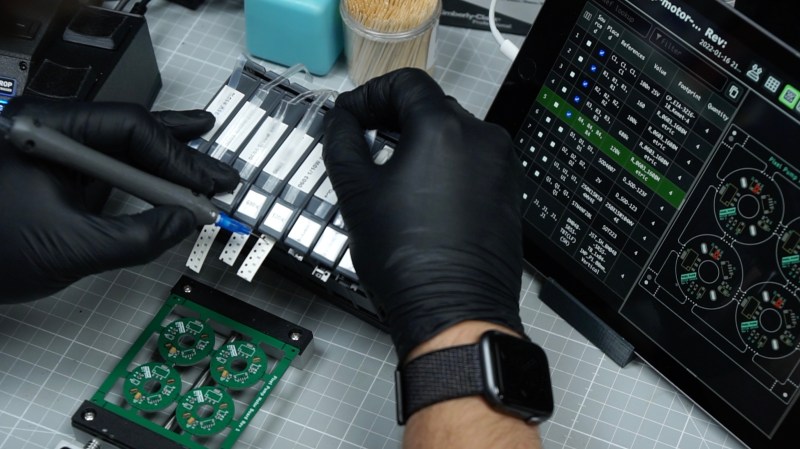The Pixel Pump is an open source manual pick & place assist tool by [Robin Reiter], and after a long road to completion, it’s ready to ship. We first saw the Pixel Pump project as an entry to the 2021 Hackaday Prize and liked the clean design and the concept of a completely open architecture for a tool that is so valuable to desktop assembly. It’s not easy getting hardware off the ground, but it’s now over the finish line and nearly everything — from assembly to packaging — has been done in-house.

Because having parts organized and available is every bit as important as the tool itself, a useful-looking companion item for the Pixel Pump is the SMD-Magazine. This is a container for parts that come on SMD tape rolls. These hold components at an optimal angle for use with the pickup tool, and can be fixed together on a rail to create project-specific part groups.
A tool being open source means giving folks a way to modify or add features for better workflows, and an example of this is [Robin]’s suggestion of using a foot pedal for hands-free control of the interactive BoM plugin. With it, one can simply use a foot pedal to step through a highlighted list of every part for a design, an invaluable visual aid when doing hand assembly.
The Pixel Pump looks great, but if you’d prefer to go the DIY route for vacuum pickup tools you would certainly be in good company. We’ve seen economical systems built for under $100, and systems built around leveraging bead-handling tools intended for hobbyists. On the extreme end there’s the minimalist approach of building a tool directly around a small electric vacuum pump.














I was surprised to find an inexpensive vacuum tool available from RS components, a £23 battery-electric pump which is actually cheaper than the rubber bladder devices that don’t work.
https://uk.rs-online.com/web/p/pick-up-tools/2222160
(compare the the £95 rubber bladder device, P/N 406-3774)
I use one for assembling locks, and it is vaguely OK.I have no doubt that a remote-pump device, such as this article is about, would work rather better.
I have no trouble at all believing that the Pixel Pump is 5x better than the Weller thingy.
That looks pretty awesome and the ability to integrate it with the BOM is probably incredibly helpful for larger layouts. A vacuum pump is a game changer when it comes to placing SMD quickly. For a more budget friendly optiobt, those bulb pencils are not great, but I bought a pick-it-up by beadsmith electric pump from an online auction website for $30 and it has saved me countless hours. I bent a solder paste needle and stuck it on the end and was comfortable using it in minutes.
I’m really surprised no one uses a sub-woofer, a piece of wood with a hole in for the vacuum pipe. All done, It can suck, in can blow, it’s easily controlled, quiet, available, quick, powerful, The only thing it can’t do, is sustain a high volume of flow in any one direction. In picking up SMD parts that’s a non issue.
Do you have any further details, or illustrations of this?
Looks like I’ll have to build one…
A lot of pnp people complain that the correct way is to suck, and blow a small puff on put down. This will do both. I’ll build something and upload a video.
I worked on a seismic sensor a while back and we used a subwoofer as an actuator for very low frequency, high amplitude signals, like .1Hz, 2-3cm. The problem is that the coil can’t withstand near DC for very long.
I’ve been using a $4 zit pump from the dollar store.(dollar Ramma) Been using it for over a year now. works great
I’ve got an Aoyue standalone SMT vacuum pickup station I bought like 15 years ago… I actually just happened to be using it–for the first time in forever–in a pointless little video clip I posted a couple weeks back about desoldering ICs. 🤷♂️ https://www.instagram.com/p/Ct8BHcMAPFS/
This seems pretty cool though, definitely gonna take a closer look at it! 🤔
Modified aquarium pump to provide a vacuum, 3D printed splice valve in the plastic aquarium tubing with hole covered by finger from hand not being used to place part, remove finger to release part. 3D printed splice valve is used because the hole in an aquarium tubing T-adapter doesn’t allow vacuum to be released instantly.